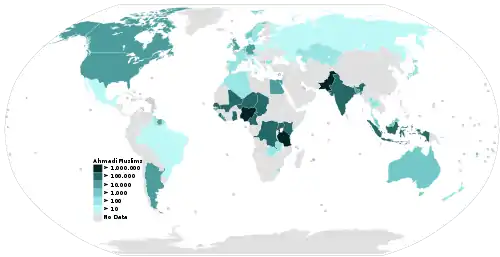| Ahmadiyya by country |
|---|
 |
আহ্মদীয়া মুসলিম জামা’ত, বাংলাদেশ | |
| Formation | 1913 |
|---|---|
| Type | Religious Community |
| Headquarters | Bakshibazar, Dhaka |
| Website | www |
Ahmadiyya is a growing minority Islamic sect in Bangladesh. Although the first Bengalis to join the sect did covert during the lifetime of Mirza Ghulam Ahmad, the sect was first established as a community in the region of Bengal in 1913 by Syed Muhammad Abdul Wahed, during the Caliphate of Hakeem Noor-ud-Din. As the worldwide community is itself is an highly organised group under the Caliph, the national community works under the name Ahmadiyya Muslim Community Bangladesh or Ahmadiyya Muslim Jama'at Bangladesh (Bengali: আহমদীয়া মুসলিম জামা'ত, বাংলাদেশ; abbrv. AMJB). There are an estimated 100,000 Ahmadis in the country as of 2004.[1][2]
History

The Ahmadiyya movement is thought to have reached Bengal in 1905, with Ahmad Kabir Noor Muhammad of Anwara, Chittagong pledging allegiance to Mirza Ghulam Ahmad. He was then followed by Rais Uddin Khan of Kishoreganj. His wife Syeda Azizatunnisa also pledged allegiance and thus became the first Ahmadi woman from Bengal. In 1909, a student named Mubarak Ali from Bogra visited Qadian where he became a member of the movement. The Ahmadiyya movement gained speed in 1912 after the allegiance of Syed Muhammad Abdul Wahid Ahmadi, a Brahmanbarian mawlana. The Ahmadiyya Muslim Community became officially established in Bengal in 1913 with the name of "Anjuman e Ahmadiyya".[3]
Ahmad Taufiq Choudhury, who belonged to the Sunni zamindar family of Selbaras,[4] joined the Ahmadiyya movement where he became the regional leader of Khuddam-ul Ahmadiyya in Sylhet. He later migrated to Mymensingh and became the Ameer (leader) of Ahmadiyya Muslim Jamaat Bangladesh after independence.[5][6]
Persecution
Since its establishment in Bangladesh, members of the Ahmadiyya Muslim Community have faced persecution from other Muslim groups. In 1963 two Ahmadis were killed in Brahmanbaria. In 1992, the Ahmadiyya headquarters in Dhaka were attacked by a mob and a number of Qurans & other books were burnt. In 1999, a bomb blast at an Ahmadiyya mosque killed seven people. On 29 October 2003, an Ahmadi Imam named Shah Alam in Roghunathpurbak village in Jhikargachha upazila of Jessore was killed.[7] In 2004, the International Khatme Nabuyat Movement (IKNM) besieged several Ahmadiyya mosques countrywide.[8] In 2004, the Government of Bangladesh banned all religious texts of the Ahmadiyya community.[9]
On 17 June 2010 an angry mob vandalised an Ahmadiyya mosque and the house of an Ahmadiyya believer at Ghatail upazila in Tangail Thursday.[10] In February 2013, a mob set fire to Ahmadiyya property at a site which had been prepared to hold the community's centenary celebrations, causing tens of millions worth of damage in local currency.[11]
Countrywide centers

- The Bangali Ahmadiyya Community currently has 120 local chapters across the country, in 425 cities and villages.[12]
- There are 65 missionaries, an MTA (Muslim Television Ahmadiyya) studio in Dhaka and a Jamia Ahmadiyya (Missionary Training College).[12]
- Maharajpur Mosque in the Natore District [13]
- Ahmadiyya Muslim Mosque in Khulna[13]
- Galim Gazi Mosque in Betal, Kishoregonj[13]
References
- ↑ "Bangladesh bans Islam sect books". BBC News. January 9, 2004. Retrieved February 22, 2014.
- ↑ "Bangladesh Religious Freedom 2007". US Department of State. Retrieved 2007-01-01.
- ↑ Babul, Jahangir (2010). আহমদিয়াতের ইতিহাসে বাংলার স্মরণীয় ব্যক্তিত্ত্ব (in Bengali). Ahmadiyya Muslim Jamaat Bangladesh. pp. 5, 7, 36, 65, 66. ISBN 978-984-99102-0-6.
- ↑ Muhammad Jahangir Babul (31 July 2014). "অবিস্মরণীয় নাম: আলহাজ্জ আহমদ তৌফিক চৌধুরী" (PDF). The Fortnightly Ahmadi (in Bengali). Ahmadiyya Muslim Jama'at, Bangladesh. 77 (2): 29–30. Archived from the original (PDF) on 21 January 2022. Retrieved 6 May 2022.
- ↑ AK Rezaul Karim (15 October 2005). "Zikr-e-Khair". The Fortnightly Ahmadi (in Bengali). Ahmadiyya Muslim Jama'at, Bangladesh. 68 (6/7).
- ↑ "Death Anniversary". The Daily Star (Bangladesh). 10 August 2011.
- ↑ "Bangladesh: Continued attacks on the Ahmadiyya community | Women Reclaiming and Redefining Cultures". Wluml.org. Archived from the original on 2012-12-06. Retrieved 2012-12-05.
- ↑ "Religious Persecution of Ahmadiyya Muslim Community - Updates April-June, 2004". Thepersecution.org. Retrieved 2012-12-05.
- ↑ "Ahmadiyya books banned". The Daily Star. Archived from the original on 2019-08-09. Retrieved 2019-08-09.
- ↑ "Ahmadiyyas in Tangail attacked - The Daily Star, Bangladesh". Thepersecution.org. Retrieved 2012-12-05.
- ↑ "Bangladesh: Ahmadiyya persecution overview; New Religion". newreligion.eu. Archived from the original on 2013-10-05. Retrieved 2013-08-08.
- 1 2 Ahmadiyya Muslim Mosques Around the World, pg. 118
- 1 2 3 Ahmadiyya Muslim Mosques Around the World, pg. 119